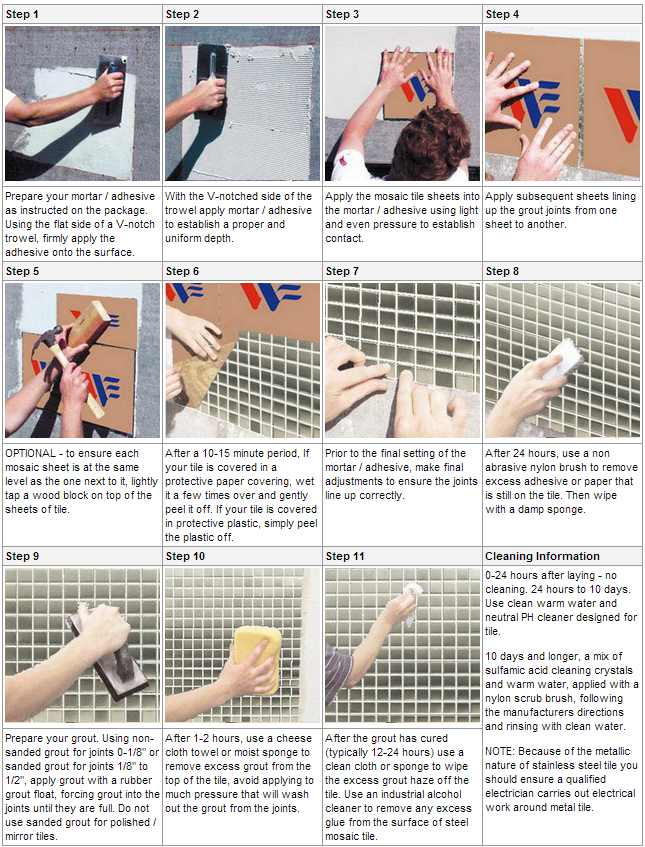Stainless steel is a very common choice for material used for making mosaic tiles. This is due to the fact that stainless steel has properties that are very desirable when it comes to tile constructing.
These properties are:
● It is lightweight;
● It doesn't oxidize easily;
● It cannot just simply stretch or discolor;
● The shine it has can last for more than 20 years…
So, it is safe to say that stainless steel is a very durable material.
People have had these kinds of mosaic tiles installed as various, both commercial and residential interior decorations. Some have put them on walls, floors and ceilings, while others have put them on backsplashes, countertops, various water features, and so on.
Full and detailed mosaic tiles installation guide on ExoTiles.
The following article is concerned with tips on how people should perform the installation process, when stainless steel mosaic tiles are concerned:
● At the very beginning, it is very important to note that the installation process of these kinds of mosaic tiles should be done by people that are experts in the field. This is because you have to watch out for various possible problems. For example, if any sort of electrical work is being done around the tiles, people can get electrocuted easily (since metal is a good conductor of energy). Also, care is required in places where high temperatures will surround the stainless steel (fireplaces, stoves, etc.), as well as extremely cold places. Furthermore, if you are installing this kind of mosaic tiles, you should avoid installing them in places that may be subject to impact by a strong force, or where there is heavy abrasion. Having all this in mind, you can conclude that an expert hand is somewhat necessary.
● Sometimes, stainless steel mosaic tiles can be installed on gently curved surfaces. In order for them to have uniformity between each individual tile, the tiles themselves have to be manipulated. This is done by using both larger and smaller individual tiles. This design can end up being very stunning and impressive.
● The substrate (the underlying layer) should be prepared well. It should be fixed, flat, cleaned of all contaminant materials such as dust, or oil, or paint, and it should be dried properly. All this is done in order for the tiles to get attached to the substrate correctly. Special care is required in humid areas, such as bathrooms and kitchens. The material usually used for substrates is concrete, cement and is some cases treated plywood.
● Waterproof membranes are also a very important thing to have when installing tiles made out of stainless steel. They are used to prevent water leakage through walls and floors. Special care is advised when adding the membrane up the wall and outside shower areas. Actually, the waterproof membrane system is advised to be used in all wet and humid areas. Keep in mind that some systems may require the use of a primer.
● There are various adhesives (glues) available on the market for purposes of installing tiles. It is highly advisable to follow the instructions provided by the adhesive manufacturer within the package point by point. There are many brands of adhesives available on the market and most of them are suitable for installing stainless steel tiles. The most commonly used are cement-based adhesives. They are usually recommended for places where no movement is anticipated. On the other hand, there are modified cement-based adhesives that can be used where there is movement.
● Grout is used to fill up the spaces between the tiles and to keep them joined together. For the best possible results, a constant use of a firm sponge is advised. This is due to the fact that grout gets separated from the tiles after it is dried. So, therefore, you should apply the grout at least 2 (in some cases more than 2) times. The second time the grout is supposed to be non-sanded.
So, after you have gone through all this, you should end up with having stainless steel tiles installed wherever you want. Now, you are advised to clean them regularly, in order for them to keep their original shape for as long a period of time as possible. Most stains can be cleaned just by the usage of a small cloth or sponge to which you can add a soft detergent. Fingerprint stains can be cleaned with olive oil. Just do not use soap or bleach, as it can damage the tiles.







No comments:
Post a Comment